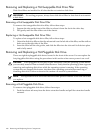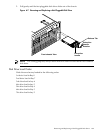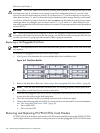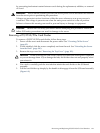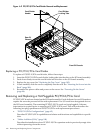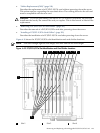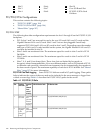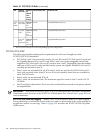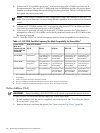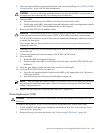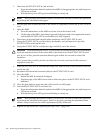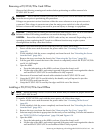
2
Slot 2
10
Slot 10
6
Slot 6
7
Slot 7
3
Slot 3
11
Core I/O Board Slot
1284
PCI/PCI-X/PCIe Card
Dividers
Slot 8Slot 4
PCI/PCI-X/PCIe Configurations
This section contains the following topics:
• “PCI/PCI-X IOBP” (page 194)
• “PCI/PCI-X/PCIe IOBP” (page 196)
• “Shared Slots” (page 197)
PCI/PCI-X IOBP
The following describes configuration requirements for slots 1 through 10 on the PCI/PCI-X/ I/O
backplane:
• PCI-X slots 1 and 2 are reserved for use by the core I/O cards SAS core I/O cards and the
Gigabit Ethernet LAN core I/O card. Slots 1 and 2 are not hot-pluggable. Install only
supported PCI-X SAS and LAN core I/O cards in slots 1 and 2. Depending upon the number
and type of SAS core I/O cards installed on the system, the Gigabit Ethernet LAN core I/O
card may be installed in slot 10.
• Slots 3 and 4 are nonshared slots. The maximum speed for cards in slots 3 and 4 is PCI-X
266 MHz.
• Slots 5 and 6 are nonshared slots. The maximum speed for cards in slots 5 and 6 is PCI-X
133 MHz.
• Slots 7, 8, 9, and 10 are shared slots. These four slots are limited by bus-mode or
frequency-related incompatibilities. If you use different modes, such as PCI instead of PCI-X,
or different card speeds in a shared bus environment, the slot automatically downgrades to
the lesser mode or speed. The maximum capability of each slot is PCI-X 66 MHz. See “Shared
Slots” (page 197) for more information.
PCI/PCI-X Card Path Logging Some PCI/PCI-X failures result in I/O path logging. These paths
help to indicate the source of the error and can be included in the error message or logged into
console or event logs.Table 6-1 describes the PCI/PCI-X I/O paths for the server.
Table 6-1 PCI/PCI-X I/O Paths
EFI Device PathHP-UX Device PathLocation
(as
viewed
from
rear of
chassis)
Function
with Path
Slot
Acpi(HWP0002,400)/Pci(1*)0/4/1/*Left-most
slot
(private;
nearest
to power
supply)
SAS core
I/O card
1
Acpi(HWP0002,400)/Pci(2*)0/4/2/*2nd
from left
(private)
Dual port
Gigabit
LAN
(Core I/O
LAN)
1
2
194 Removing and Replacing Server Components





